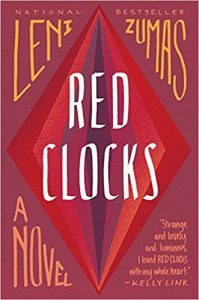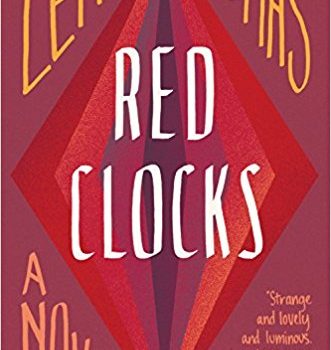Ian Mond Reviews Red Clocks by Leni Zumas
 Red Clocks, Leni Zumas (Little, Brown and Company 978-0316434812, $26.00, 368pp, hc) January 2018.
Red Clocks, Leni Zumas (Little, Brown and Company 978-0316434812, $26.00, 368pp, hc) January 2018.
Given that both novels deal with reproductive rights under a repressive regime, it’s not surprising that critics would compare Leni Zumas’s Red Clocks with Margaret Atwood’s The Handmaid’s Tale. The key difference is that while Atwood’s classic is a dystopia where a Christian theocracy has established control, Zumas’s novel is set in the here and now. This makes Red Clocks the more horrifying prospect. It’s not to say that The Handmaid’s Tale isn’t a harrowing, disturbing novel, but it can – to a narrowing extent in a post- Trump world – be viewed as a cautionary tale. The conceit of Red Clocks, in which the United States Government passes a law that provides embryos with personhood and bans abortion and in-vitro fertilization, reads like a bill penned by Vice President Mike Pence currently wending its way through Congress.
Red Clocks is set in Oregon and alternates between the perspectives of four women. They are introduced to the reader as the Biographer, the Mender, the Wife, and the Daughter. Ro Stephens, the Biographer, is a single woman who wants to have a child. As IVF is banned, she undergoes the process of insemination. This means taking the fertility drug, Clomid, which stimulates ovulation but also has a range of awful side effects, especially after prolonged use. Ro is racing against time to get pregnant, partly because of her age, partly because the cost of the procedure is exhausting her bank account, and partly because the Government’s regressive legislation will soon ban single parents from adopting.
Desperate, Ro turns to Gin Percival (the Mender) who lives alone in the forest with her two goats. She is a self-taught herbalist, tending to women that can’t afford the steep price of health care. Gin’s desire to save Lola, the abused wife of the school principal, leads to trumped up charges of medical malpractice and conspiracy to commit murder (the offence for those who perform abortions).
One of Ro’s most gifted students, Mattie (the Daughter) falls pregnant after having unprotected sex with her insensitive boyfriend, Ephraim. With her bright future as a mathematician, a scientist, or an engineer under threat, Mattie risks imprisonment and attempts to cross the “Pink Wall,” the heavily patrolled border between the States and Canada, and the aspect of the book that most resembles The Handmaid’s Tale.
Ro’s fellow teacher, Didier, is married to Susan (the Wife). Didier, outwardly, is a lovely bloke, outgoing and compassionate, but at home, while not abusive or violent, he refuses to acknowledge that his marriage is broken. Susan wants to repair the damage but struggles to broach the question of marriage counseling because she knows how her husband will react.
If there’s a consistent theme to each of the four character-arcs, it’s that men are terrible. It’s not just the men who passed regressive legislation into law, it’s also Didier’s passive-aggressive attitude towards Susan, it’s Ephraim’s disregard for Mattie’s future, it’s the obstetrician’s couldn’t-care-less treatment of Ro’s infertility issues, and worst of all, it’s the school principal regularly beating his wife. It’s not subtle, it’s not nuanced, and two years ago I might have criticized Zumas for this strawman approach. But with the litany of abuse and sexual harassment charges leveled at men in positions of power as part of the #MeToo movement, it’s hard to ignore that the strawman has more flesh on its bones than we first thought or, frankly, were willing to admit.
Horrible men aside, Zumas also critiques society’s tendency to pigeon-hole women. Throughout the book, there is a fifth female voice that appears at the end of each chapter. This is Eivør Mínervudottír, a fictional 19th Century polar explorer and the subject of Ro’s biography. At one point Ro and Susan chat about Eivør and whether her life would have been more meaningful if she’d stayed at home rather than explore the polar reaches.
“Depends what you mean by ‘meaningful,”‘ said the biographer. “I don’t see how gutting fish and washing six kids’ underwear by hand is equal to doing research in the Arctic Circle.”
“Why not?”
“One is repetitive and mindless, and the other is thrilling, courageous, and beneficial to the lives of many people.”
“If she’d raised six kids,” said Susan, “she would’ve been beneficial to their lives.”
It’s the either-or attitude expressed by both women that Zumas questions. Why can’t a polar explorer have a meaningful life as a wife, a mother, an artist and a philosopher? Why is the meaningful life only relevant to men, free to straddle multiple roles? Maybe it’s because when we shoe-horn women into specific functions, it’s easier to restrict their freedoms and rights, hand personhood to an embryo, but treat a woman like a cog in the patriarchy.
Red Clocks is a smart, provocative, and thoughtful novel. It provides hope that the society it depicts will always remain speculative.
This review and more like it in the July 2018 issue of Locus.
 While you are here, please take a moment to support Locus with a one-time or recurring donation. We rely on reader donations to keep the magazine and site going, and would like to keep the site paywall free, but WE NEED YOUR FINANCIAL SUPPORT to continue quality coverage of the science fiction and fantasy field.
While you are here, please take a moment to support Locus with a one-time or recurring donation. We rely on reader donations to keep the magazine and site going, and would like to keep the site paywall free, but WE NEED YOUR FINANCIAL SUPPORT to continue quality coverage of the science fiction and fantasy field.








